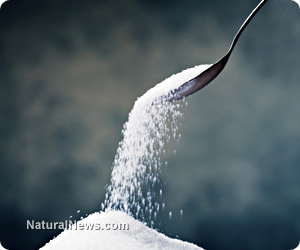If you still like Civet Coffee...
 In 1999, The Independent
published an article entitled “World’s top sweetener is made with GM
bacteria,” which revealed that Monsanto was knowingly adding aspartame
to soft drinks in the United States – and that aspartame is made from GM
bacteria. This report, which remains one of the earliest disclosures on
aspartame in a mainstream newspaper, received little attention after
its publication – possibly because its implications were underestimated
at the time – and it has long been forgotten.
In 1999, The Independent
published an article entitled “World’s top sweetener is made with GM
bacteria,” which revealed that Monsanto was knowingly adding aspartame
to soft drinks in the United States – and that aspartame is made from GM
bacteria. This report, which remains one of the earliest disclosures on
aspartame in a mainstream newspaper, received little attention after
its publication – possibly because its implications were underestimated
at the time – and it has long been forgotten.
http://www.freepatentsonline.com
Patent confirms that aspartame is the excrement of GM bacteria
 In 1999, The Independent
published an article entitled “World’s top sweetener is made with GM
bacteria,” which revealed that Monsanto was knowingly adding aspartame
to soft drinks in the United States – and that aspartame is made from GM
bacteria. This report, which remains one of the earliest disclosures on
aspartame in a mainstream newspaper, received little attention after
its publication – possibly because its implications were underestimated
at the time – and it has long been forgotten.
In 1999, The Independent
published an article entitled “World’s top sweetener is made with GM
bacteria,” which revealed that Monsanto was knowingly adding aspartame
to soft drinks in the United States – and that aspartame is made from GM
bacteria. This report, which remains one of the earliest disclosures on
aspartame in a mainstream newspaper, received little attention after
its publication – possibly because its implications were underestimated
at the time – and it has long been forgotten.
Since 1999, the world has become a little more attentive to Monsanto
and aspartame, but ignorance still abounds about the latter’s genesis.
While more and more people are starting to awaken to aspartame’s
destructive effects on our health, do they know how it is actually made?
Fortunately, a 1981 patent for aspartame production, once confined to
the drawers of patent offices, is now available online for everyone to
see – and it confirms everything that Monsanto was happy to tell us in
1999 before their meteoric growth necessitated greater prudence.
The production process
The patent, which is entitled Process for producing aspartame and is credited to Bahl, Rose, and White, summarizes the process as follows:
“The artificial sweetener aspartame, a dipeptide with the formula
Asp-Phe-me, is produced using a cloned micrcorganism [sic]. A DNA which
codes for a large stable peptide comprised of the repeating amino acid
sequence (Asp-Phe)n is inserted into a cloning vehicle which in turn is
introduced into a suitable host microorganism. The host microorganism is
cultured and the large peptide containing the repeating Asp-Phe
sequence is harvested therefrom. The free carboxyl group of the large
peptide is benzylated and then hydrolysed to benzyl Asp-Phe dipeptides.
This dipeptide is methylated and then debenzylated to form aspartame.”
This scientific jargon obfuscates (perhaps deliberately) a truly disturbing process:
1.) ‘Cloned microorganisms’ (which the patent later reveals to be genetically modified E. coli) are cultivated in tanks whose environments are tailored to help them thrive.
2.) The well-fed E. coli cultures defecate the proteins that contain the aspartic acid-phenylalanine amino acid segment needed to make aspartame.
3.) The proteins containing the Asp-Phe segments are ‘harvested’ (i.e. lab assistants collect the bacteria’s feces).
4.) The feces are then treated. This includes a process of
methylation (adding an excess of the toxic alcohol, methanol, to the
protected dipeptide).
While common sense dictates that this abomination doesn’t belong
anywhere near our bodies, the patent’s authors made no secret about
their belief that aspartame constitutes a safe and nutritious sweetener:
“Aspartame is not only sweeter than sucrose, but is preferable as a
food to sucrose. While sucrose can provide the body with little more
than energy, aspartame is composed of amino acids, the building blocks
of body proteins, and like other proteins is broken down by the
digestive enzymes in the stomach to its constituent amino acids thus
providing nutritive value. [...] For these reasons, aspartame holds
significant promise in replacing sugar as a sweetener.”
So there we have it: An official document that not only reveals the
shocking truth behind aspartame production, but also freely admits that
it was intended for mass consumption as a sucrose substitute. Therefore,
the next time someone claims that your reservations about this
sweetener are unfounded, direct them to this patent – the truth behind
aspartame is now in plain view.
Sources for this article include:http://www.freepatentsonline.com
About the author:
Michael Ravensthorpe is an independent writer whose research interests include nutrition, alternative medicine, and bushcraft. He is the creator of the website Spiritfoods, through which he promotes the world’s healthiest foods, whether they be established superfruits such as mangosteen or lesser-known health supplements like blackstrap molasses.
Article pages: 1 2
Michael Ravensthorpe is an independent writer whose research interests include nutrition, alternative medicine, and bushcraft. He is the creator of the website Spiritfoods, through which he promotes the world’s healthiest foods, whether they be established superfruits such as mangosteen or lesser-known health supplements like blackstrap molasses.
This article was posted: Sunday, August 25, 2013 at 7:35 am
No comments:
Post a Comment